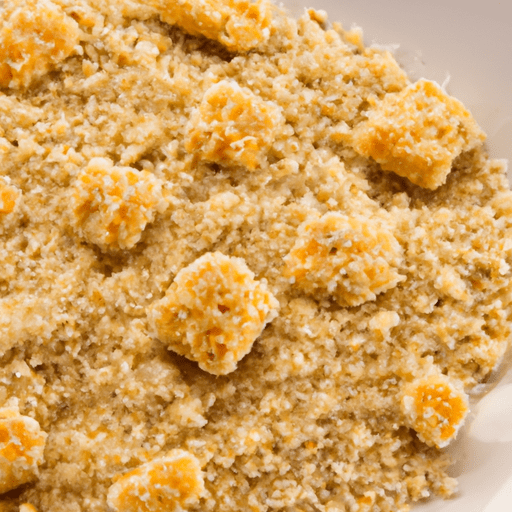Gluten Free Panko Breadcrumbs: A Tasty Twist to Your Culinary Creations
Do you love the crunch and texture that breadcrumbs bring to your favorite dishes? If you follow a gluten-free diet or have gluten sensitivities, you may think that traditional breadcrumbs are off-limits. But fear not! Gluten-free panko breadcrumbs are here to save the day, offering a delectable alternative that can be enjoyed by everyone. In this post, we’ll explore the world of gluten-free panko breadcrumbs, delving into their taste, common uses in cooking, nutritional value, and some fascinating facts.
Taste and Texture: A Crispy Delight
Gluten-free panko breadcrumbs have a delightfully light and crispy texture that elevates any dish. Panko, a type of Japanese breadcrumb, is made by grinding bread without crusts into airy, jagged flakes. The result is a coarser texture compared to traditional breadcrumbs. Unlike regular breadcrumbs, panko has a unique ability to maintain its crunchiness, even when used as a topping on baked or fried foods.
Common Uses in Cooking
Gluten-free panko breadcrumbs are incredibly versatile in the kitchen, making them a pantry essential. They can be used to coat and add an appealing golden crust to an array of dishes. Consider using them to make gluten-free versions of classic favorites like breaded chicken cutlets, fish fillets, or even crispy onion rings. Additionally, panko breadcrumbs can be used as a topping for casseroles, gratins, and macaroni and cheese, providing a tantalizing contrast to creamy and cheesy dishes.
Nutritional Value: A Healthier Choice
While many traditional breadcrumbs contain gluten and offer little nutritional value, gluten-free panko breadcrumbs can be a healthier alternative. Typically made from a combination of gluten-free flours, such as rice or corn, they are free from additives or preservatives, ensuring a more wholesome option for those with dietary restrictions. Plus, they are often lower in calories and fat compared to regular breadcrumbs, adding another reason to incorporate them into your cooking repertoire.
Interesting History and Facts
Did you know that panko breadcrumbs were introduced to Japan by Portuguese traders in the 16th century? This culinary exchange led to the development of panko as a distinctly Japanese style of breadcrumb. The word “panko” even comes from the Portuguese word “pão,” meaning bread. The technique of making panko involves baking bread using an electric current to create a unique texture.
Throughout its history, panko has been embraced by chefs around the world for its ability to create a light and airy coating. In recent years, the popularity of gluten-free diets has sparked the production of gluten-free panko breadcrumbs, allowing individuals with gluten sensitivities or celiac disease to enjoy the satisfying crunch and delicious flavor without worry.
Conclusion
Gluten-free panko breadcrumbs open up a world of culinary possibilities for those avoiding gluten. With their light and crispy texture, they can help you achieve that perfect golden crust on your favorite dishes. From breaded chicken to crispy casseroles, the versatility of gluten-free panko breadcrumbs knows no bounds. And with their lower calorie and fat content, they offer a healthier alternative to traditional breadcrumbs. So why not add a delightful crunch to your next meal with gluten-free panko breadcrumbs? Your taste buds will thank you!
Note: When shopping for gluten-free panko breadcrumbs, always double-check the label to ensure they are certified gluten-free, as cross-contamination can sometimes occur during production.
Gluten-Free Panko Breadcrumbs
Origin and Common Uses: Panko breadcrumbs originated in Japan and have gained popularity worldwide. They are made from white bread without crusts, providing a light and crispy texture. Gluten-free panko breadcrumbs are a variation made from gluten-free bread, usually without wheat flour, making them suitable for those with gluten intolerance or celiac disease. They are commonly used as a coating for fried or baked dishes, such as schnitzel, chicken fingers, vegetable fritters, or as a topping for casseroles and gratins.
Nutritional Benefits: Gluten-free panko breadcrumbs often contain a mixture of flours such as rice flour, cornstarch, or a combination of gluten-free grains. They are typically low in fat and a good source of carbohydrates. However, the nutritional content can vary depending on the brand and ingredients used.
Unique Properties and Historical Significance: Panko breadcrumbs have a distinct texture compared to traditional breadcrumbs. They have a lighter, crisper, and crunchier texture, giving dishes a desirable crispy coating. Panko breadcrumbs were introduced to Japan by Portuguese traders in the 16th century during their exploration of the east. Over time, they became a beloved ingredient in Japanese cuisine and eventually spread globally due to their unique texture and versatility.
Note: It’s important to always check ingredient labels when purchasing gluten-free panko breadcrumbs, as some brands may have additional additives or allergens.




Use the share button below if you liked it.
It makes me smile, when I see it.